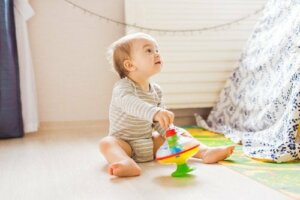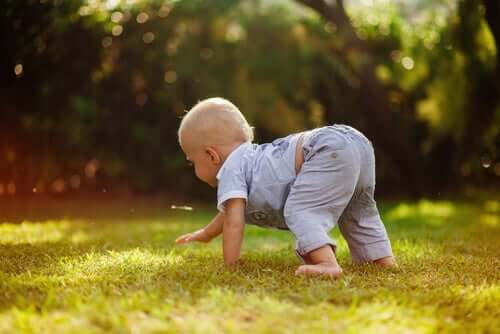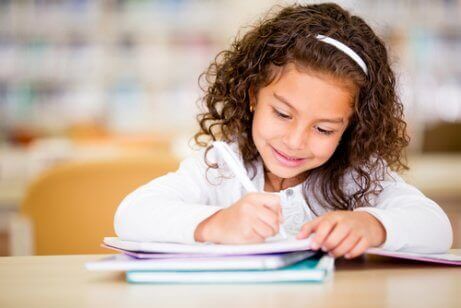The Development of Spatial Awareness in Children


Written and verified by lawyer Francisco María García
The development of spatial awareness in children conditions their location in the environment in which they’re found and their learning in school and in life. Depending on their age, the ability to establish these references will improve.
As the notion of space develops, the child begins to form the idea of their own body, of their body scheme. This means that they make up a mental image of their body in relation to the environment. From this representation, the knowledge of the world will evolve.
At first, the little one will have their own body as a reference, and little by little, they’ll reach the abstractions of adult thought.
The development of spatial awareness in children
The notion of space in children evolves in parallel with the rest of their thinking.
Up to 2 years
- The notion of space is reduced to the possibilities they have to move. Space is what they see.
- They have their own body as their main reference.
- Although they perceive spatial relationships between things, they still can’t internalize them. Therefore, for them, things “disappear” when they aren’t present in their visual space.
2 to 6 years
- Children develop a still limited idea of space. They understand the specific space of their house, that of relatives whom they visit frequently, and of their school. They’re spaces with which they have emotional relationships. Their space is “here”.
- They understand simple spatial relationships: Top-bottom, front-back, for example. These relationships are fundamental for the evolution of spatial awareness in children.
- Their notion of distance is very unique. For them, the distance between two objects is shortened if a third object is interposed between them.
- They fail to encompass the notion of neighborhood, city, or country. Perhaps they’ll memorize the name of the city or the country in which they live, but it will be for them only a label without content.
“At first, little ones will have as a reference their own body, and little by little, they’ll reach the abstractions of adult thought”
From 6 to 11 years old
- Their localization ability progresses. Little by little, they free themselves from their egocentricity, which allows the advance of objective observation. They’re able to perceive a place even though they haven’t been in contact with it before. They understand the “beyond”, referring to unknown places.
- Little by little, they acquire the concept of a local and national medium. Their notion of space is broadening.
- With objective observation, they’re able to analyze and represent space. For example, they can draw a row of trees with perspective. The largest will represent the closest, the smallest the far. The changes in size will show their idea of spatial distances.
- They acquire the notion of geographic space. They’re able to locate a known place on a map and understand what a map represents.
- As they grow, their concept of space is consolidated. They manage to orient themselves and not get lost using external references, such as a building or a sign in their path, for example.

From 12 years of age
- Puberty is a stage of important changes, not only physical, but also conceptual. Adolescent thinking moves with abstractions and no longer with images of tangible things. Their notion of space no longer depends on the concrete, but on conceptualizations.
- The notion of space completes its development and allows mental representations of dimensions that aren’t verifiable with the sense organs. Children manage to understand astronomical concepts, such as the distances between planets or stars.
How to promote the development of spatial awareness in children
Psychopedagogy affirms that the development of the notion of space in children conditions learning in general. It has a very direct impact on literacy and mathematics.

Therefore, it’s important that parents and teachers become facilitators in order to stimulate and promote this development.
The process
In early childhood, you have to work on the “lived space” through direct experience. It’s important to allow children to explore the physical spaces they’re in. This involves letting them crawl, sit on the ground, and scoot around.
You also need to offer the child games in which the concepts of right-left, front-back, before-after, up-down, inside-outside, near-far and beginning-end, are stimulated.
Outings, walks, and tours are excellent opportunities to promote the development of the concept of space.
Although psychopedagogy presents generalizations that can be taken as parameters, we should never forget that each child constitutes an individual case and that’s how they should be addressed.
The development of spatial awareness in children conditions their location in the environment in which they’re found and their learning in school and in life. Depending on their age, the ability to establish these references will improve.
As the notion of space develops, the child begins to form the idea of their own body, of their body scheme. This means that they make up a mental image of their body in relation to the environment. From this representation, the knowledge of the world will evolve.
At first, the little one will have their own body as a reference, and little by little, they’ll reach the abstractions of adult thought.
The development of spatial awareness in children
The notion of space in children evolves in parallel with the rest of their thinking.
Up to 2 years
- The notion of space is reduced to the possibilities they have to move. Space is what they see.
- They have their own body as their main reference.
- Although they perceive spatial relationships between things, they still can’t internalize them. Therefore, for them, things “disappear” when they aren’t present in their visual space.
2 to 6 years
- Children develop a still limited idea of space. They understand the specific space of their house, that of relatives whom they visit frequently, and of their school. They’re spaces with which they have emotional relationships. Their space is “here”.
- They understand simple spatial relationships: Top-bottom, front-back, for example. These relationships are fundamental for the evolution of spatial awareness in children.
- Their notion of distance is very unique. For them, the distance between two objects is shortened if a third object is interposed between them.
- They fail to encompass the notion of neighborhood, city, or country. Perhaps they’ll memorize the name of the city or the country in which they live, but it will be for them only a label without content.
“At first, little ones will have as a reference their own body, and little by little, they’ll reach the abstractions of adult thought”
From 6 to 11 years old
- Their localization ability progresses. Little by little, they free themselves from their egocentricity, which allows the advance of objective observation. They’re able to perceive a place even though they haven’t been in contact with it before. They understand the “beyond”, referring to unknown places.
- Little by little, they acquire the concept of a local and national medium. Their notion of space is broadening.
- With objective observation, they’re able to analyze and represent space. For example, they can draw a row of trees with perspective. The largest will represent the closest, the smallest the far. The changes in size will show their idea of spatial distances.
- They acquire the notion of geographic space. They’re able to locate a known place on a map and understand what a map represents.
- As they grow, their concept of space is consolidated. They manage to orient themselves and not get lost using external references, such as a building or a sign in their path, for example.

From 12 years of age
- Puberty is a stage of important changes, not only physical, but also conceptual. Adolescent thinking moves with abstractions and no longer with images of tangible things. Their notion of space no longer depends on the concrete, but on conceptualizations.
- The notion of space completes its development and allows mental representations of dimensions that aren’t verifiable with the sense organs. Children manage to understand astronomical concepts, such as the distances between planets or stars.
How to promote the development of spatial awareness in children
Psychopedagogy affirms that the development of the notion of space in children conditions learning in general. It has a very direct impact on literacy and mathematics.

Therefore, it’s important that parents and teachers become facilitators in order to stimulate and promote this development.
The process
In early childhood, you have to work on the “lived space” through direct experience. It’s important to allow children to explore the physical spaces they’re in. This involves letting them crawl, sit on the ground, and scoot around.
You also need to offer the child games in which the concepts of right-left, front-back, before-after, up-down, inside-outside, near-far and beginning-end, are stimulated.
Outings, walks, and tours are excellent opportunities to promote the development of the concept of space.
Although psychopedagogy presents generalizations that can be taken as parameters, we should never forget that each child constitutes an individual case and that’s how they should be addressed.
All cited sources were thoroughly reviewed by our team to ensure their quality, reliability, currency, and validity. The bibliography of this article was considered reliable and of academic or scientific accuracy.
- Acredolo, L. P. (1978). Development of spatial orientation in infancy. Developmental Psychology, 14(3), 224. https://psycnet.apa.org/record/1979-25547-001
- Guillín Verdesoto, B. C. (2014). Actividades lúdicas en el desarrollo de las nociones espaciales en los niños y niñas de 4 a 5 años, de nivel inicial 2, de la Escuela Matilde Hidalgo de Prócel Quito, período 2013-2014 (Bachelor’s thesis, Quito: UCE). http://200.12.169.19/bitstream/25000/5610/1/T-UCE-0010-775.pdf
- Isaza, M., & López, A. V. (2012). Propuesta didáctica según Van Hiele para el desarrollo de la noción de espacio en los niños y niñas de primero de primaria del Liceo Cuba de la ciudad de Pereira-Risaralda (Doctoral dissertation, Universidad Tecnológica de Pereira. Facultad de Ciencias de la Educación. Licenciatura en Pedagogía Infantil).
- Marchesi, A. (1983). Conceptos espaciales, mapas cognitivos y orientación en el espacio. Estudios de psicología, 4(14-15), 85-92. https://www.tandfonline.com/doi/abs/10.1080/02109395.1983.10821355
- Martín Lázaro, P. (2014). Acercamiento al concepto de espacio en Educación Infantil. https://uvadoc.uva.es/bitstream/handle/10324/7273/TFG-G736.pdf?sequence=1&isAllowed=y
-
Ried Luci, A. (2015). La experiencia de ocio al aire libre en contacto con la naturaleza, como vivencia restauradora de la relación ser humano-naturaleza. Polis. Revista Latinoamericana, (41). https://journals.openedition.org/polis/11128
- Silvestre, N. E. P. (2011). La psicomotricidad y la construcción del espacio. Scientia, 1(1), 1-9. http://ojs.uab.edu.bo/ojs/index.php/scientia/article/view/41/36
This text is provided for informational purposes only and does not replace consultation with a professional. If in doubt, consult your specialist.








